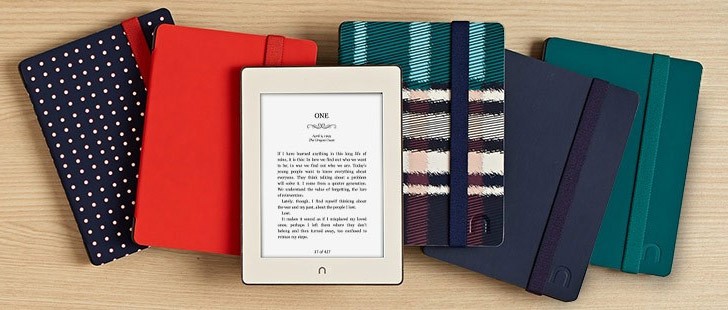The Onyx Boox Note Air is one of the most financially successful digital note taking devices of 2020. There has been such strong demand, that it has sold out three times, in less than a month. This really shows how an all new design and refined stylus can resonate with so many people. Not to mention, it is very affordable, it retails for $479. Meanwhile, the Max Lumi is likely the best 13.3 inch that the company has ever made. It is oozing bleeding edge performance and power. PDF documents are at its mercy, thanks to the A4 screen. All of this comes at a cost, it retails for $879.
The Onyx Boox Max Lumi features a 13.3 inch E INK Mobius and Carta HD display, with a PMMA flat cover-lens. The resolution is 2200×1650 with 207 DPI, which will be great for reading ebooks. This device is primarily geared towards taking notes and editing PDF files, the A4 screen can read them, without having to pinch and zoom. The WACOM layer has full support for palm rejection and the accompanied stylus has 4,096 degrees of pressure sensitivity, the harder you press, the thicker the lines will be.
The Lumi is the first 13.3 inch e-note that has a front-lit display, with a series of white and amber LED lights, so you can read in the dark and also control the color temperature system. You will finally be able to be productive day or night. It has 32 different adjustable controls to give you full control over the lights.
Underneath the hood is an Qualcomm Snapdragon 636 processor with eight custom Kryo 260 cores at up to 1.8 GHz, an Adreno 509 GPU, 4GB of DDR4 RAM and a whopping 64GB of internal storage. You will be able to connect up to the internet via Wi-Fi (2.4GHz + 5GHz) + BT 5.0. You will be able to connect the Lumi to your PC or MAC with the USB Type-C port and it also supports OTG for driver free accessories, such as a keyboard. It is powered by a giant 4300m batter, which provides up to six weeks of standby mode. Quick Charge 4.0 can provide 2/3 of the battery power for Max Lumi in just two hours. There is a fingerprint sensor, which allows you to lock or unlock the device, which adds a bit of security from unauthorized access. You can connect up the Lumi to your PC or MAC via the HDMI port and use it as a secondary monitor. There are also twin stereo speakers.
The Note Air features a 10.3 inch E INK Carta HD Display with a resolution of 1872×1404 and 227 PPI. The screen made of glass and it is flush with the bezel. The back is made of a blue brushed aluminum and has an orange racing stripe on the side, the Onyx logo is the same color. On the side is your speaker, power button and USB-C port. All of the other sides are clean and have no ports or anything else. The front of the device almost has a dual bezel system. The front is piano black and the right hand side of the screen is blue, with an orange Onyx logo. This is a very interesting industrial design, something that Onyx has never really done before.
Like many 10.3 inch e-notes on the market, this employs a front-lit display with both white and amber LED lights. There are 18 white LED lights, and 18 amber LED lights, for a total 36 LED lights. This system is designed so you can read at night or lowlight environments, and adjust the illimnosity via a software based slider bar.
Underneath the hood of the Note Air is a Qualcomm Snapdragon 636 processor, 3GB of RAM and 32GB of internal storage. It has Bluetooth 5.0 to connect up wireless accessories, such as headphones or a speaker to listen audiobooks, music or podcasts. It also has a built-in speaker if you don’t feel like plugging in extra accessories. You can charge and transfer data with the USB-C port, which also has OTG. It is powered by a 3,000 mAh battery and you can surf the internet with Wi-Fi (2.4GHz + 5GHz). There is also a gyroscope, to automatically switch orientation.
What are the things these two devices have in common? They both have the same processor, run Android 10 and have Google Play. They have a really good lighting system, although the Note Air is better, due to the extra LED lights. They have the latest OS3, so you can run two apps at the same time, and have advancements to the drawing app, so you can use layers, new templates, new pen/pencil types.
Who are these products designed for? Inevitably people will say, I can buy an iPad for this type of money and get more functionality. E INK fundamentally is easy on the eyes and the battery lasts 2-3 weeks, not 1 or 2 days. Onyx gears the Max and Air towards creatives and professionals, who want a device geared towards productivity. You can freehand draw, make notes, edit PDF files/ebooks. There is minimal distractions with these type of devices, you are not going to be barraged with notifications and phone calls. Android provides a ton of flexibility to send your edited PDF files or notes to the cloud storage solution of your choice or just send them via email.
This comparison video below, gives you an overview of what they bring to the table, in real world conditions. If you are on the fence on buying either of these, this video will lend an assist.
Michael Kozlowski is the editor-in-chief at Good e-Reader and has written about audiobooks and e-readers for the past fifteen years. Newspapers and websites such as the CBC, CNET, Engadget, Huffington Post and the New York Times have picked up his articles. He Lives in Vancouver, British Columbia, Canada.

